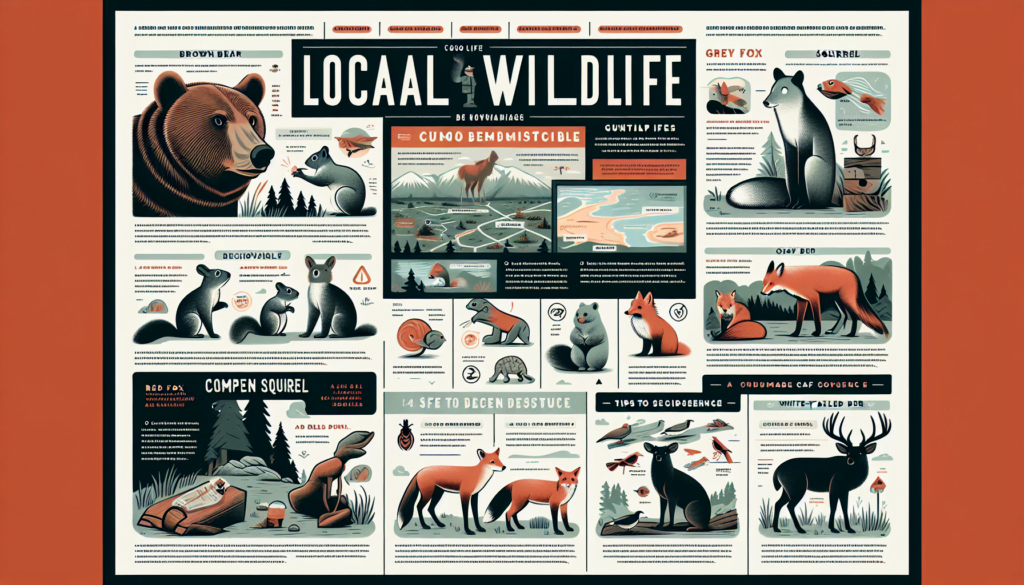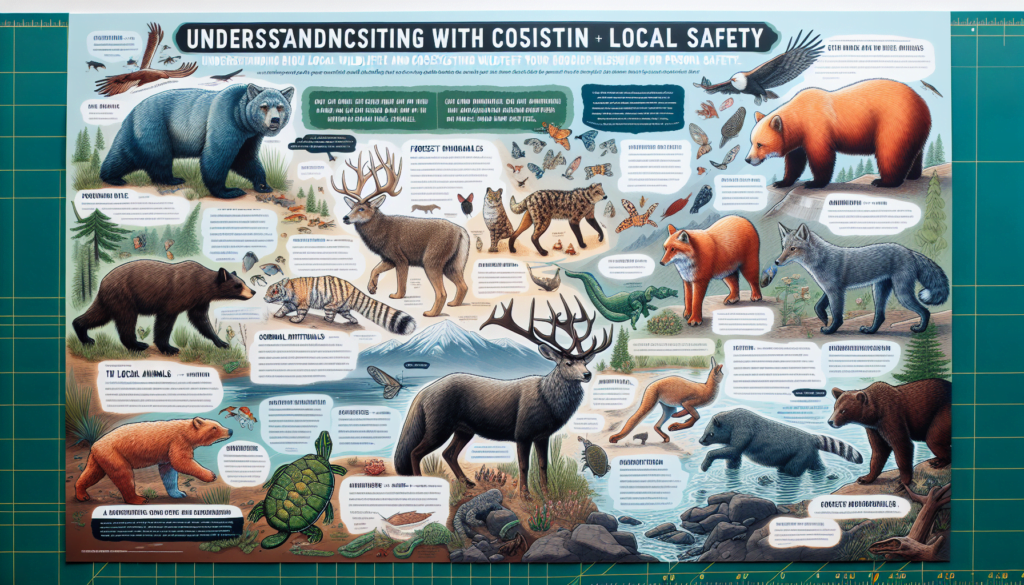People often venture into unknown territories without considering the potential hazards posed by the wildlife inhabiting those areas. In order to ensure their safety, a thorough understanding of the local wildlife becomes paramount. From avoiding encounters with dangerous animals to knowing how to respond in case of an encounter, being well-informed about the local wildlife can make a significant difference between a delightful experience and a potentially dangerous situation. This article explores the crucial aspects of comprehending the local wildlife, equipping readers with essential knowledge to stay safe in foreign environments.

Table of Contents
1. Identifying Local Wildlife
1.1 Common animal species
When exploring new areas, it is important to familiarize oneself with the common animal species that inhabit the region. This knowledge can help individuals identify and understand the behaviors of the wildlife they may encounter. Local wildlife authorities or field guides can provide valuable information on the most frequently observed animals in a specific area. From birds to mammals and reptiles to amphibians, recognizing these common species is the first step towards safely interacting with local wildlife.
1.2 Native and invasive species
Differentiating between native and invasive species is crucial for both understanding the local ecosystem and minimizing potential risks. Native species have evolved in a particular region and typically contribute to the ecological balance. On the other hand, invasive species are non-native organisms that can harm the local environment by outcompeting native species or disrupting natural processes. Understanding which species are native and which are invasive can help individuals protect local biodiversity while also avoiding potential hazards.
1.3 Wildlife behavior
Gaining insights into wildlife behavior is essential for both personal safety and responsible wildlife observation. Knowing how certain species behave can help individuals predict their actions and maintain a safe distance. For example, understanding that some animals are more active during specific times of the day or year can help visitors adjust their activities accordingly. Additionally, recognizing warning signs of aggression or territoriality can help prevent dangerous encounters. Wildlife behavior varies greatly between species, making it imperative to research and understand the behavior of local wildlife.
1.4 Tracks and signs
One effective way to identify local wildlife is by examining their tracks and signs. Animal tracks, scat, nests, and other traces left behind can provide valuable clues about which species have been present in an area. By learning to interpret these signs, individuals can gain insights into the animals’ movements, feeding habits, and territories. It is important to note that an understanding of tracks and signs should be acquired through reliable sources or expert guidance to avoid misinterpretation, as incorrect identification could lead to inappropriate actions or unnecessary risks.
2. Understanding Wildlife Habitats
2.1 Terrestrial habitats
Terrestrial habitats refer to the ecosystems found on land, including forests, grasslands, deserts, and various other environments. Understanding the characteristics of these habitats is crucial for recognizing and appreciating the diversity of wildlife that calls them home. Different animal species thrive in different types of terrestrial habitats, relying on specific food sources, shelter, and environmental conditions. By studying these habitats, individuals can become more knowledgeable about the local wildlife they may encounter and gain a deeper understanding of the interconnectedness between species and their habitats.
2.2 Aquatic habitats
Aquatic habitats encompass freshwater bodies such as lakes, rivers, and wetlands, as well as marine environments like oceans and seas. These habitats support an array of unique wildlife, ranging from fish and marine mammals to amphibians and waterfowl. Understanding the characteristics of aquatic habitats can help individuals appreciate and respect their delicate ecosystems. Furthermore, recognizing the different species that inhabit these habitats can contribute to responsible wildlife observation and conservation efforts.
2.3 Urban and suburban environments
Wildlife is not limited to remote or natural areas; many species have adapted to urban and suburban environments. Cities and towns can provide surprisingly diverse habitats for various wildlife, including birds, small mammals, and reptiles. Understanding the interactions between wildlife and urban environments can help individuals coexist with these creatures while minimizing potential conflicts. Recognizing the challenges faced by urban wildlife, such as habitat loss and food scarcity, can drive efforts to create more wildlife-friendly cities and promote responsible practices by residents.
2.4 Seasonal variations
Seasonal variations play a significant role in wildlife behavior, habitat use, and migration patterns. Understanding how local wildlife adapts to and interacts with seasonal changes is vital for appreciating the intricacies of their lives and ensuring personal safety. For example, some species hibernate during the winter months, while others migrate to warmer regions. Being aware of these seasonal behaviors can help individuals plan their activities accordingly and avoid disrupting critical wildlife processes.
3. Potential Hazards and Risks
3.1 Poisonous and venomous wildlife
One potential hazard when encountering local wildlife is the presence of poisonous or venomous species. Certain animals, such as snakes, spiders, or some marine creatures, possess venom that can cause harm or even be lethal to humans. Understanding which species in the area are poisonous or venomous is crucial for personal safety. It is advisable to educate oneself about the physical characteristics and behaviors of these species, as well as the appropriate responses in case of an encounter.
3.2 Aggressive or territorial species
Another potential risk involves encounters with aggressive or territorial wildlife. Animals may display aggressive behaviors if they feel threatened, are protecting their young, or are establishing their territory. Recognizing the warning signs of aggression, such as raised fur, hissing, or growling, can help individuals assess the situation and take appropriate actions. Maintaining a safe distance and respecting the animal’s space can often prevent aggressive encounters and reduce the risk of harm.
3.3 Disease transmission
Wildlife can carry various diseases that have the potential to be transmitted to humans. Understanding the risks of disease transmission is essential for personal safety when interacting with wildlife. For instance, ticks may carry diseases such as Lyme disease, while certain animals can carry rabies. Taking preventive measures, such as wearing appropriate clothing, using insect repellent, and avoiding contact with sick or dead animals, can significantly lower the risk of disease transmission.
3.4 Harmful plants and insects
In addition to wildlife, it is important to be aware of potentially harmful plants and insects in the local area. Some plants may have toxic properties or cause allergic reactions upon contact, while certain insects can deliver painful bites or stings. Being able to recognize and avoid these hazards can help individuals stay safe while enjoying outdoor activities. Researching local poisonous plants, conducting regular checks for ticks, and carrying necessary medical supplies for allergic reactions are important precautions to prevent injuries and discomfort.
4. Effective Wildlife Observation
4.1 Maintaining a safe distance
When observing wildlife, it is crucial to maintain a safe distance to protect both the animals and oneself. Approaching wildlife too closely can disturb their natural behaviors and potentially lead to dangerous situations. Each species has different comfort distances, so it is essential to research and understand the appropriate distances for the animals being observed. Binoculars and spotting scopes can be valuable tools for getting a closer look at wildlife while maintaining a respectful distance.
4.2 Using binoculars and cameras
Binoculars and cameras are indispensable tools for wildlife observation. They allow individuals to observe wildlife from a distance without causing disturbance or compromising safety. Binoculars are particularly useful for birdwatching, as they provide detailed views of birds without the need to approach them closely. Cameras, both still and video, enable individuals to capture and document their wildlife encounters, contributing to scientific research and personal enjoyment. However, it is important to remember that the welfare of the animals should always take precedence over capturing the perfect shot.
4.3 Responsible wildlife feeding
Feeding wild animals may seem like a way to interact with them, but it can lead to several negative consequences. Wildlife that becomes reliant on human-provided food may suffer from malnutrition or lose their natural foraging behaviors. Feeding can also increase the risk of disease transmission among animals or create aggressive behavior patterns. It is essential to respect the natural diets and feeding habits of wildlife by refraining from feeding them and discouraging others from doing so as well.
4.4 Reporting wildlife sightings
Reporting wildlife sightings to local authorities or wildlife organizations can contribute to conservation efforts and help monitor the health and population trends of various species. Observations of rare or endangered species, as well as unusual behaviors or distributions, are particularly valuable. By sharing these sightings, individuals can actively participate in the protection and preservation of local wildlife while also providing important data for research and management purposes.

5. Responding to Wildlife Encounters
5.1 Staying calm and avoiding sudden movements
When encountering wildlife, it is crucial to remain calm and avoid sudden movements. Sudden motions or loud noises can startle animals and potentially trigger defensive or aggressive behaviors. By staying calm and composed, individuals can assess the situation and make informed decisions to protect their safety and the well-being of the animals. If feeling threatened, slowly backing away from the animal while maintaining eye contact can help diffuse potential conflicts.
5.2 Backing away slowly from aggressive animals
Encountering aggressive animals can be unsettling, but it is important not to panic. If confronted by an aggressive animal, backing away slowly and deliberately can help deescalate the situation. Avoid direct eye contact, which can be interpreted as a threat, and try to create distance without turning your back to the animal. It is crucial not to run, as this may trigger a predator-prey response and cause the animal to give chase. By maintaining a calm demeanor and slowly removing oneself from the animal’s vicinity, the chances of a successful resolution to the encounter are increased.
5.3 Dealing with common urban wildlife encounters
In urban areas, interactions with wildlife are increasingly common. Squirrels, raccoons, and pigeons are just a few examples of animals that have adapted to urban environments. When encountering urban wildlife, it is important to remember that they are still wild animals and should not be approached or fed. Secure trash containers and avoid leaving pet food outside, as this can attract wildlife closer to residential areas. In cases where wildlife poses a threat to public safety or demonstrates aggressive behavior, contacting local authorities or wildlife control agencies is the recommended course of action.
5.4 Safety precautions during outdoor activities
When engaging in outdoor activities, it is crucial to take appropriate safety precautions to minimize the risk of unwanted wildlife encounters. Carrying bear spray or other approved deterrents can provide a sense of security in areas where large predators are present. Making noise while hiking or camping, particularly in areas with limited visibility, can alert wildlife to your presence and reduce the chances of surprising them. Understanding and respecting seasonal wildlife behaviors, such as avoiding nesting areas during breeding seasons, can also help minimize potential conflicts.
6. Wildlife Crossings and Traffic Safety
6.1 Understanding wildlife migration patterns
Wildlife often follows specific migration patterns to access essential resources, breeding grounds, or wintering areas. Understanding these migration patterns can help individuals anticipate wildlife crossings and take appropriate precautions while driving. Researching local wildlife migration routes, such as deer crossings or bird flyways, can contribute to safer roads and reduce the risk of vehicle collisions with wildlife.
6.2 Significance of wildlife corridors
Wildlife corridors are critical pathways that connect different habitats, allowing animals to move between fragmented landscapes. These corridors are essential for maintaining healthy populations and genetic diversity. Recognizing and protecting wildlife corridors is vital for allowing animals to safely navigate through human-dominated areas and avoid roadways or development. By supporting efforts to conserve and establish wildlife corridors, individuals can help mitigate the negative impacts of habitat fragmentation on local wildlife.
6.3 Road signs and awareness
Road signs play a crucial role in wildlife safety, particularly in areas with frequent wildlife crossings. Signs that alert drivers to the potential presence of wildlife can help increase awareness and encourage caution. Following speed limits and constantly scanning the surroundings can also improve response time when encountering wildlife on roads. Drivers should be prepared to slow down or stop if necessary to allow animals to safely cross, reducing the risk of collisions and potential injuries to both humans and wildlife.
6.4 Vehicle collisions with wildlife
Vehicle collisions with wildlife can have devastating consequences for both humans and animals. To reduce the chances of such accidents, drivers should be vigilant, particularly during dawn and dusk when wildlife is more active. Slowing down in wildlife-prone areas, using high beams when appropriate, and being prepared for sudden animal movements can significantly decrease the risk of collisions. In case of a collision, it is important to report the incident to local authorities and take appropriate actions to ensure personal safety and assist injured animals.

7. Protecting Wildlife and Habitats
7.1 Responsible waste management
Improper waste management can have detrimental effects on wildlife and their habitats. Litter, especially plastic, can entangle or be ingested by animals, leading to injuries or fatalities. Properly disposing of waste and participating in community clean-up initiatives can help mitigate this threat and protect wildlife. Additionally, reducing single-use plastics and practicing recycling can contribute to long-term conservation efforts by minimizing pollution and habitat degradation.
7.2 Keeping pets under control
Pets, particularly cats and dogs, can significantly impact local wildlife if allowed to roam freely. These domestic animals can disrupt natural behaviors, disturb nesting sites, and even harm or kill native species. Keeping pets on leashes or within enclosed areas can help minimize their impact on wildlife and prevent confrontations. Responsible pet ownership and adhering to local leash laws are important steps towards coexisting harmoniously with local wildlife.
7.3 Preventing habitat destruction
Habitat destruction is one of the primary threats to wildlife populations worldwide. Activities such as deforestation, urban expansion, and pollution degrade and fragment essential habitats for numerous species. To mitigate habitat destruction, individuals can support conservation organizations, advocate for sustainable land-use practices, and participate in reforestation or habitat restoration initiatives. By actively engaging in these efforts, individuals can contribute to the protection and preservation of local wildlife and their habitats.
7.4 Conservation initiatives and organizations
Various conservation initiatives and organizations play a crucial role in protecting local wildlife. Supporting these initiatives through donations, volunteer work, or participation in citizen science programs can have a significant impact on wildlife conservation. Conservation organizations often conduct research, advocate for policy changes, and implement on-the-ground conservation measures that directly benefit local wildlife populations. By actively engaging with and supporting these organizations, individuals can contribute to the long-term preservation of natural habitats and the species that depend on them.
8. Birdwatching Safety Tips
8.1 Identifying bird species
Birdwatching is a popular activity that allows individuals to observe and appreciate the diversity of bird species. Identifying different bird species requires knowledge of their physical characteristics, behaviors, and habitats. Field guides or birding apps can assist in recognizing and learning about various bird species in the local area. With this knowledge, birdwatchers can enjoy their hobby while also respecting the needs and well-being of the birds they encounter.
8.2 Protecting nesting areas
Birds construct intricate nests to lay and hatch their eggs, which are essential for continuing their populations. Disturbing or damaging nesting areas can have serious consequences for bird species. Keeping a safe distance from nesting birds and their habitats helps protect their breeding efforts and minimize stress or abandonment. Pay attention to signs indicating the presence of nesting birds and avoid approaching or trespassing into restricted areas during their breeding season.
8.3 Avoiding disturbing migratory patterns
Migratory birds travel vast distances during their annual migrations, relying on specific stopover sites for rest and refueling. Disturbing these birds during migration can interrupt their journey and deplete their energy reserves, potentially hindering their ability to complete the migration successfully. Avoiding known migration areas or maintaining a respectful distance can help protect these birds and ensure their successful migration.
8.4 Recognizing hazardous areas for nesting birds
Certain areas, such as coastal beaches or marshes, are crucial nesting habitats for birds. Protecting these areas and recognizing their importance is essential for bird conservation efforts. Following designated trail systems, avoiding off-trail walking, and respecting any posted restrictions can help minimize disturbances to nesting birds and their habitats. By being aware of the needs of nesting birds, individuals can contribute to their protection and help safeguard their populations.

9. Dangers in Marine Environments
9.1 Understanding beach and ocean hazards
Marine environments present unique risks and hazards that individuals should be aware of when enjoying activities near or in the water. Hazards such as rip currents, large waves, and sudden changes in weather conditions can pose dangers to swimmers, surfers, and boaters. Understanding the specific hazards associated with the local beaches or ocean areas can help individuals make informed decisions and take appropriate safety precautions while enjoying the marine environment.
9.2 Dealing with jellyfish and marine creature stings
Jellyfish and other marine creatures, such as certain species of sea anemones or coral, can cause painful stings or bites. It is important to be familiar with common species found in the local area and understand appropriate responses in case of contact. Vinegar or specialized sting treatments can often help alleviate the pain from jellyfish stings, while following proper diving or snorkeling protocols can minimize interactions with potentially harmful marine life.
9.3 Avoiding sharks and other dangerous marine species
Sharks, though often feared, play a vital role in healthy marine ecosystems. While most encounters with sharks are harmless, it is important to take precautions to minimize the risk of negative interactions. This includes avoiding swimming during times of increased shark activity, like dawn or dusk, and respecting any local advisories or restrictions. By being knowledgeable about the local shark species and their behaviors, individuals can enjoy marine environments safely and with respect for these magnificent creatures.
9.4 Rip currents and water safety
Rip currents, powerful narrow channels of water moving away from shore, can pose significant risks to swimmers. It is essential to understand how to identify and respond to rip currents to ensure personal safety. Avoiding swimming alone, swimming near lifeguarded areas, and refraining from panicking or fighting the current in case of being caught are all important measures. By being aware of the potential dangers and following recommended safety guidelines, individuals can enjoy marine environments while minimizing the risk of accidents.
10. Local Laws and Regulations
10.1 Protected species and restrictions
Local laws and regulations often provide protection for certain species that are threatened or endangered. It is essential to be aware of these protected species and any restrictions that may apply to their habitats. Disturbing or harming protected species, including their nests or habitats, can result in serious legal penalties. Understanding and respecting these regulations is crucial for fostering conservation efforts and ensuring the long-term survival of threatened or endangered species.
10.2 Hunting and fishing regulations
For those interested in hunting or fishing, it is imperative to understand and comply with local hunting and fishing regulations. These regulations help manage wildlife populations, protect ecosystems, and ensure sustainable practices. Familiarizing oneself with bag limits, species-specific regulations, and licensing requirements is essential to avoid legal consequences and promote responsible hunting and fishing practices.
10.3 Reporting wildlife disturbances or illegal activities
Reporting wildlife disturbances or illegal activities to local authorities or wildlife agencies is crucial for maintaining the well-being of local wildlife populations. Suspicious activities, such as poaching, habitat destruction, or illegal wildlife trafficking, should be promptly reported to the appropriate authorities. Being vigilant and proactive in reporting these activities can help uphold the law, protect wildlife, and contribute to the overall conservation efforts in the area.
10.4 Ethical considerations for wildlife photography
Wildlife photography is a popular hobby that allows individuals to capture and document the beauty of local wildlife. However, ethical considerations must be prioritized when photographing wildlife. It is important to always prioritize the welfare of the animals and avoid behavior that may cause stress or negative impacts. Following guidelines such as the Leave No Trace principles and adhering to the rules of ethical wildlife photography, including obtaining permits if required, can ensure that wildlife is observed and photographed responsibly.
In conclusion, understanding the local wildlife is essential for both personal safety and the well-being of the animals encountered. By identifying common species, recognizing wildlife behaviors, and understanding their habitats, individuals can engage in responsible wildlife observation and minimize potential risks. It is important to be aware of potential hazards, such as poisonous wildlife or aggressive species, and take appropriate precautions to prevent encounters that may lead to harm. Responsible waste management, respecting local regulations, and supporting conservation initiatives are all vital to protecting wildlife and their habitats. With proper knowledge and consideration, individuals can enjoy and appreciate local wildlife while ensuring their own safety and the preservation of these remarkable creatures for future generations.

Related site – Top 10 Tips to Stay Safe & Have Fun Outdoors
Backlog of Passport Applications Finally Cleared
